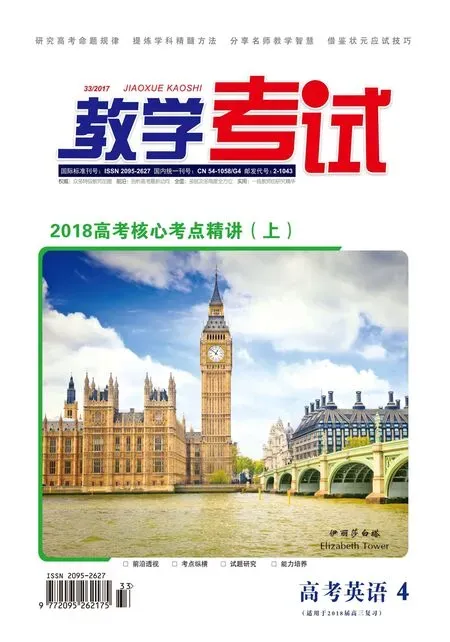短文改错考点聚焦与解题策略
河南 巴朝军
短文改错考点聚焦与解题策略
河南 巴朝军
短文改错是集考查语法规则和语言技能于一体的综合性试题,重点考查学生的基础语法知识和综合语言运用能力,旨在检测学生发现、判断、纠正短文中错误的能力。仔细研究全国各省市高考试题后不难发现,该题型主要从词法、句法、行文逻辑、一致性这四个方面考查学生在语篇中运用英语的准确性。
第一部分 词法
(一)名词:主要是名词单复数错误
【解题策略】首先判断该名词是可数名词还是不可数名词。
1. 不可数名词,没有复数形式。
2. 可数名词需与其前的限定词、文中相关信息保持数的一致。
【典例1】(2016·全国新课标卷Ⅱ)If we go on a trip abroad,we can broaden your (our) view and gain knowledges we cannot get from books.
【答案与解析】knowledges→knowledge。knowledge为不可数名词,不用复数形式。
【典例2】(2016·浙江卷)When I was a very young children,my father created a regular practice.
【答案与解析】children→child。因为前面有不定冠词a,所以用单数。
【典例3】(2015·四川卷)As I tell(told) you last time,I made three new friend here.
【答案与解析】friend→friends。句中的three表明此处应用名词的复数形式。
(二)冠词:试题设计聚焦于冠词的特指与泛指,固定词组中的冠词以及习惯用法
【解题策略】
1. 单数可数名词一般不能单独使用,要根据意思的需要使用恰当的冠词。
2. 冠词的使用不仅仅要分析单独一句话,也要联系上下文。
3. 固定词组中的冠词用法以及习惯用法需要平时的积累。
【典例4】(2016·全国新课标卷Ⅰ)She could not find work at a law firm because she was woman.
【答案与解析】woman前加a。一般情况下,表示泛指时单数可数名词前要加不定冠词。
【典例5】(2016·全国新课标卷Ⅰ)My uncle says that he never dreams(of) becoming rich in the short period of time.
【答案与解析】the→a。结合语境可知,“我”的叔叔在讲他的生意经,这里表示的是泛指“很短的一段时间”。
【典例6】(2015·全国新课标卷Ⅱ)One day,little Tony went to a shopping center with his parent(parents)....he quickly walked into the shop....he turned around and found where(that) his parents were missing....A woman saw him crying and telling him to wait outside a shop.
【答案与解析】段尾a→the。这里特指上文中提到的shop。只看本句话无法发现文中的错误,需联系上文信息。
【典例7】(2015·全国新课标卷Ⅰ)Now I am living in a city,but I miss my home in countryside.
【答案与解析】countryside前加the。in the countryside为固定词组,意思是“在农村”。
(三)代词
【解题策略】代词与所指代的名词要保持用法、人称、数、性别等的一致。
【典例8】(2016·浙江卷)Every time he arrived home at(the)end of the day,we’d greet her at the door.
【答案与解析】her→him。用him与he保持性别的一致,作greet的宾语。
【典例9】(2015·全国新课标卷Ⅰ)We must found(find)ways to protect your environment.
【答案与解析】your→our。本句的主语是We,用了第一人称,因此使用our与之呼应。
【典例10】(2015·四川卷)It’s been three Saturdays now and it really costs me many.
【答案与解析】many→much。根据语境,这里说花了“我“很多钱,应用much指代不可数名词“钱”。
(四)形容词与副词
1.形容词与名词、副词的错用
【典例11】(2016·全国新课标卷Ⅰ)My uncle tells me that the key to his success is honest.
【答案与解析】honest→honesty。根据句意“我叔叔告诉我他成功的关键在于诚实”可知此处用名词。
【典例12】(2015·陕西卷)I thought the biscuits were really well.
【答案与解析】well→good。well作形容词通常指身体健康,而此处指的是食物很好,因此改成good。
2.形容词与副词原级、比较级、最高级的不当使用
【典例13】(2016·全国新课标卷Ⅲ)The teenage year(years)from 13 to 19 were the most difficult time for me . They were also the best and worse years in my life.
【答案与解析】worse→worst。句中有表示范围的in my life,结合句意可知用最高级,与前文的最高级best 保持一致。
(五)介词
错误类型有三种,分述如下:
1.介词使用不当
【典例14】(2016·全国新课标卷Ⅲ)Now I am leaving home to college.
【答案与解析】to →for。leave A for B表示“离开A地到B地去”。
2.介词多余
【典例15】(2015·四川卷)Please help with me and give me some advice.
【答案与解析】去掉with。help是及物动词,其后直接跟宾语。
3.缺少必要的介词
【典例16】(2014·四川卷)If you hear the alarm,stand in line at the door and wait your teacher to lead you outside.
【答案与解析】wait后加for。wait 是不及物动词,后接宾语时要加上适当的介词。wait for sb. to do sth.意思是“等待某人做某事”。
(六)动词时态:错误主要表现为与上下文时态不一致
【典例17】(2016·全国新课标卷Ⅰ)It is always crowded with customers at meal times. Some people even had to wait outside.
【答案与解析】had→have。根据前一句的时态,可知这里应该用一般现在时。
【典例18】(2015·全国新课标卷Ⅰ)When I was a child,I hoped to live in the city. I think I would be happy there.
【答案与解析】think→thought。结合前文When I was a child可知,这里在回忆童年,因此用一般过去时。
(七)动词语态
【典例19】(2016·全国新课标卷Ⅰ)Every day he makes sure that fresh vegetables or(and) high quality oil are using for cooking.
【答案与解析】using→used。根据语境可知,fresh vegetables和high quality oil是“被使用”。
【典例20】(2014·陕西卷)Suddenly the arrows was(were)flying down at us from the sky—they were looked like rain!
【答案与解析】删除were或looked。look是系动词,只用于主动语态。
(八)非谓语动词:主要涉及谓语动词与非谓语动词的辨别
【解题策略】分析句子意义、结构,确定正确的动词形式,是谓语还是非谓语。
【典例21】(2014·陕西卷)One evening at sunset,we sat by the fire,have our barbecue.
【答案与解析】have→having。现在分词短语having our barbecue作状语,表示伴随的动作。
【典例22】(2015·陕西卷)“I might have to retire again next year just get some more of these biscuits.”
【答案与解析】get前加to。根据句意“我可能明年还得再退休一次,仅仅是为了吃到更多的饼干”可知,此处要用动词不定式作目的状语。
【技巧点拨】英语中,用谓语动词表达主要信息,而对谓语动词进行修饰(说明谓语动词发生的时间、原因、方式、或者是伴随动作、补充说明等)用非谓语动词。
【典例23】(2016·全国新课标卷Ⅲ)I showed them I was independent by wear strange clothes.
【答案与解析】wear→wearing。by为介词,后接动名词。
【典例24】(2015·全国新课标卷Ⅱ)A woman saw him crying and telling him to wait outside a (the) shop.
【答案与解析】telling→told。结合语境,动作tell的发出者是句子的主语A woman,而不是“him”,也就是说,此处不是宾语补足语,不与crying并列,而是与前面的谓语动词saw并列,因此是谓语动词,所以应该用一般过去时。
【技巧点拨】如果句子中有多个动作,需要判断其并列关系。
【典例25】(2016·浙江卷)It was both excited and frightening to be up there!
【答案与解析】excited→ exciting。根据语境可知,这里表示“令人兴奋的”,故用现在分词形式的形容词。
第二部分 句法
句法主要涉及句子结构的完整性,定语从句、状语从句、名词性从句中引导词的使用。
【典例26】(2016·全国新课标卷Ⅲ)At last,I will be on my own,but I still want to have my parents to turn to whenever need help.
【答案与解析】whenever后加I 。分析句子结构可知,从句中缺少主语,结合语境,从句的主语应是I。
【典例27】(2016·全国新课标卷Ⅰ)My uncle is the owner of a restaurant close to that I live.
【答案与解析】that→where。考查宾语从句,从句中缺少地点状语,因此用where引导。
【典例28】(2016·四川卷)The dishes what I cooked were Mom’s favoritiest(favorite).
【答案与解析】what→that/which或者去掉what。根据句子结构和句意可知,这里是定语从句。that/which在从句中作宾语,可以省略。
【典例29】(2015·全国新课标卷Ⅱ)After looks(looking) at the toy for some time,he turned around and found where his parents were missing.
【答案与解析】where→that或者去掉where。宾语从句意思完整,应用that引导,that可以省略。
第三部分 行文逻辑
【典例30】(2016·全国新课标卷Ⅱ)If we stay at home,it is comfortable but there is no need to spend money.
【答案与解析】but → and。结合句意“如果我们待在家里,那会很舒适且不用花钱”可知,前后文为顺承关系。
【典例31】(2015·全国新课标卷Ⅰ)There the air is clean or the mountains are green.
【答案与解析】or→and。分析句子结构可知,前后句之间为并列关系而非选择关系,因此把or 改为and。
第四部分 一致性
(一)主谓一致:谓语动词与主语没有保持人称和数的一致
【典例32】(2016·浙江卷)He would ask who we was and pretend not to knowing(know) us.
【答案与解析】was→were。这句话的主语是we,谓语应用复数,而且这篇文章是作者回忆小时候的事情,因此用一般过去时。
(二)结构一致
【典例33】(2016·全国新课标卷Ⅱ)We can chose(choose)between staying at home and take a trip.
【答案与解析】take→taking。and 连接并列成分,taking与staying并列。
河南省荥阳市教体局教研室)

